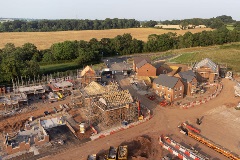
Housing Affordability Task Force Report Urges Ontario to Build 1.5 Million Homes in Next Ten Years
In December 2021, the Province of Ontario appointed the Housing Affordability Task Force (the “Task Force”) and mandated it to propose recommendations for addressing housing affordability through one main mechanism – increasing supply.
The Task Force’s report was released on February 8, 2022 (the “Report”)[i], and its tone conveys the severity of the housing crisis. Its stark statistics illustrate how so many Ontarians are easily priced out of the housing market: from 2011 to 2021 average incomes have grown only 38% while average house prices have climbed 180%; Ontario home prices have gone from an average of $329,000 in 2011 to an average of $923,000 in 2021.
The Report delivers on the supply-focused approach with 55 recommendations which could significantly change the land use planning landscape in Ontario. It also urges the Province to adopt an “ambitious but achievable target” of building 1.5 million homes in the next ten years. The majority of the Report’s recommendations focus on interventions aimed at creating the most housing units in the shortest time period. The Report’s recommendations provide a number of goals and direction for the Province:
- Set bold targets and prioritize new housing – set the goal of adding 1.5 million homes in ten years and update planning guidance to prioritize this goal;
- Higher density - allow more housing in more locations without the need for municipal approvals, limiting exclusionary zoning;
- Reduce and streamline urban design rules - set uniform provincial standards for urban design, remove rules that prioritize preservation of neighbourhood physical character, remove the requirement for municipal approval of design matters, and reduce or remove parking requirements in cities of a certain size;
- Depoliticize the land use planning process and cut red tape - limit public consultations, mandate delegation of technical decisions, prevent abuse of the heritage process, and create timelines for approvals;
- Changes to the Ontario Land Tribunal - prevent appeals with the goal of delaying projects, give adjudicators the right to award costs to proponents more frequently, reduce the decision issuance time, increase funding, and encourage the Tribunal to prioritize cases that would increase housing supply; and
- Incentivize municipalities - create the “Ontario Housing Delivery Fund” which would reward municipalities who successfully increase housing supply, reduce approval times for new housing and remove exclusionary zoning practices.
Many of the Report’s recommendations will be welcome by the development sector and the adoption of a supply-driven approach to affordability potentially signals a move away from demand-side solutions, which aim to cool the market.
The Task Force acknowledges the hole in its mandate when it draws the distinction between “housing affordability” and “affordable housing”. The Report focuses on the former – increasing the supply and affordability of market rate housing, no doubt necessary. As a result, the Report does not provide specific interventions to increase the supply of “affordable housing” (ie. homes that are bought or rented with government support). This is unfortunate, as the housing crisis is felt by Ontarians across the income spectrum.
The Report acknowledges that the Province cannot rely exclusively on increased supply and for-profit developers to solve the affordable housing problem. However, the Report’s recommendations, such as faster development approvals, will benefit both non-profit and for-profit developers. Also, the Report’s Appendix B addresses opportunities for increasing affordable housing, including partnerships between for-profit and non-profit developers which leverage their respective expertise and experience, as well as creating an Affordable Housing Trust from a portion of Land Transfer Tax revenue (i.e., the windfall resulting from property price appreciation) to create incentives for projects serving and brought forward by Black- and Indigenous-led developers and other marginalized groups.
The Task Force also weighed in on the implementation of inclusionary zoning (“IZ”), a planning tool which allows municipalities to mandate the creation of affordable housing in new developments. The Report critiques the lack of incentives to developers and density bonuses in the City of Toronto’s implementation regime, and relays the concern from developers and some housing advocates that the absence of these incentives may render projects financially unfeasible. The Task Force recommends that municipalities who implement IZ should be required to use density bonusing and other incentives in all IZ and affordable housing policies. Also, the Task Force suggests the amendment of legislation to permit municipalities to accept “cash in lieu” payments for IZ units. Adoption of cash in lieu of IZ units would provide municipalities with more flexibility to implement IZ, but if widely used could work against the policy goal of creating more affordable units in the short term.
With housing poised to be a key issue in the 2022 provincial election, the Government of Ontario could attempt to pass legislation to implement some of the Report’s changes in the coming months.
This article was written by Claudia Pedrero with the assistance of articling student Erran Lee.
[i] The Report of the Ontario Housing Affordability Task Force can be found online at: <https://www.ontario.ca/page/housing-affordability-task-force-report>.




.tmb-0.jpg?sfvrsn=65b1a474_1)
.tmb-0.png?sfvrsn=69bc5944_1)
